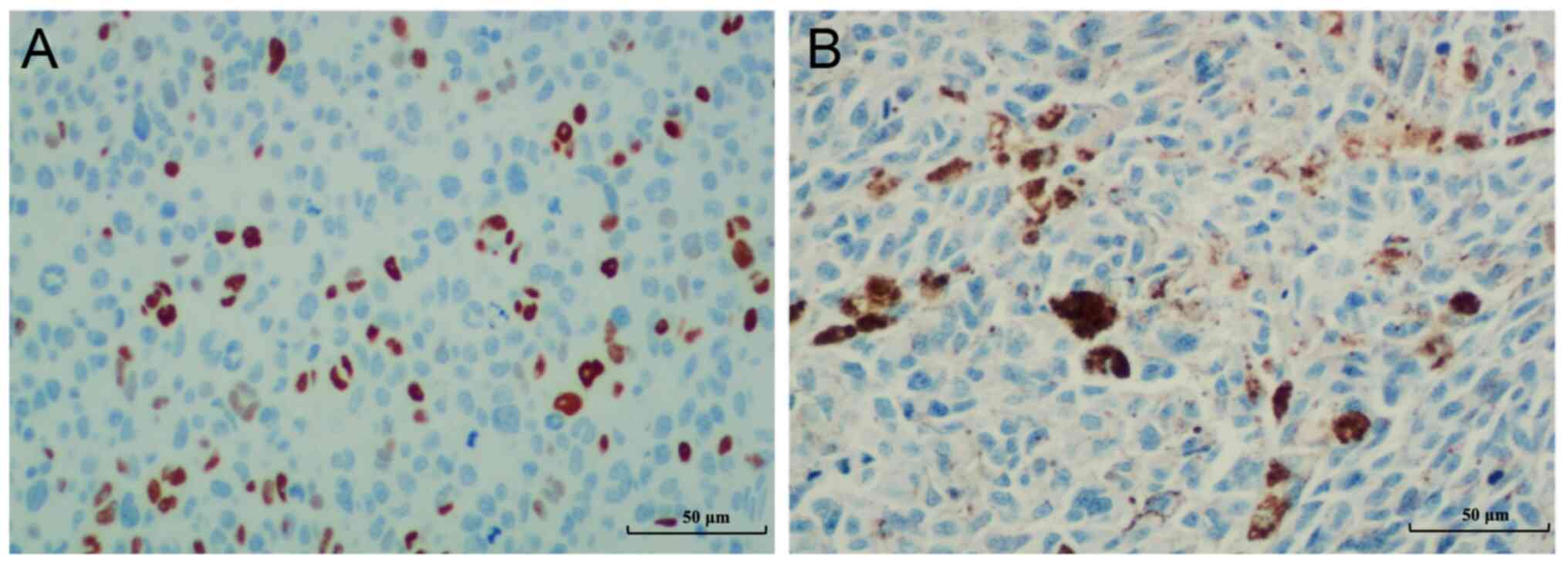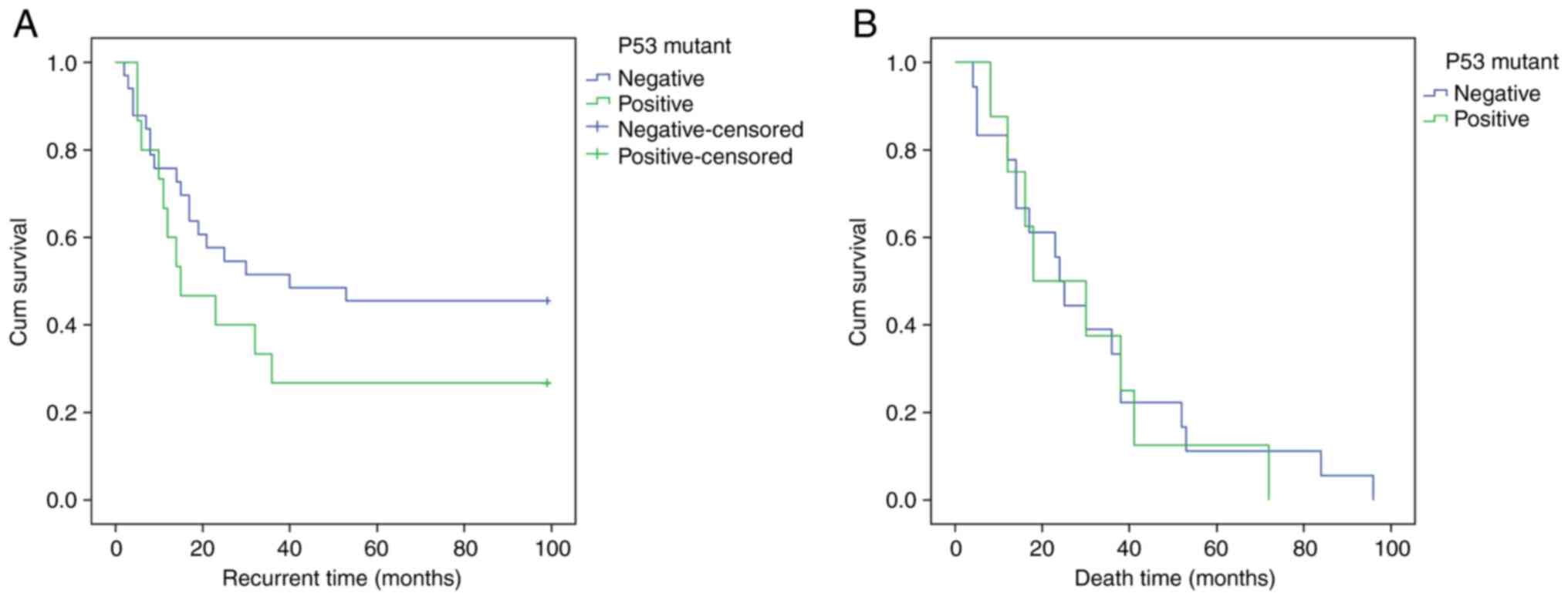|
1
|
Hassel JC and Enk AH: Melanoma. In: Kang
S, Amagai M, Bruckner AL, Enk AH, Margolis DJ, McMichael AJ and
Orringer JS (eds). Fitzpatrick's Dermatology. 9th edition. McGraw
Hill, New York, NY, pp1982-2011, 2019.
|
|
2
|
Smoller BR: Histologic criteria for
diagnosing primary cutaneous malignant melanoma. Mod Pathol. 19
(Suppl 2):S34–S40. 2006.PubMed/NCBI View Article : Google Scholar
|
|
3
|
Bandarchi B, Ma L, Navab R, Seth A and
Rasty G: From melanocyte to metastatic malignant melanoma. Dermatol
Res Pract. 2010(583748)2010.PubMed/NCBI View Article : Google Scholar
|
|
4
|
Liu Y and Sheikh MS: Melanoma: Molecular
pathogenesis and therapeutic management. Mol Cell Pharmaco.
6(228)2014.PubMed/NCBI
|
|
5
|
Loureiro JB, Abrantes M, Oliveira PA and
Saraiva L: P53 in skin cancer: From a master player to a privileged
target for prevention and therapy. Biochim Biophys Acta Rev Cancer.
1874(188438)2020.PubMed/NCBI View Article : Google Scholar
|
|
6
|
Wiriyakulsit N, Klomkleang P, Sornda T and
Kaewkong W: Melanoma: Incidence among the thai population and the
use of a molecular understanding of this cancer to improve the
strategy of targeted therapy. Thai Cancer J. 41:134–150. 2021.
|
|
7
|
Sullivan KD, Galbraith MD, Andrysik Z and
Espinosa JM: Mechanisms of transcriptional regulation by p53. Cell
Death Differ. 25:133–143. 2018.PubMed/NCBI View Article : Google Scholar
|
|
8
|
Meevassana J, Anothaisatapon K, Subbalekha
S, Kamolratanakul S, Siritientong T, Ruangritchankul K, Pungrasami
P, Hamill KJ, Angsapatt A and Kitkumthorn N: BRAF V600E
immunohistochemistry predicts prognosis of patients with cutaneous
melanoma in Thai population. Plast Reconstr Surg Glob Open.
10(e4605)2022.PubMed/NCBI View Article : Google Scholar
|
|
9
|
Ascierto PA, Kirkwood JM, Grob JJ, Simeone
E, Grimaldi AM, Maio M, Palmieri G, Testori A, Marincola FM and
Mozzillo N: The role of BRAF V600 mutation in melanoma. J Transl
Med. 10(85)2012.PubMed/NCBI View Article : Google Scholar
|
|
10
|
Shadfan M, Lopez-Pajares V and Yuan ZM:
MDM2 and MDMX: Alone and together in regulation of p53. Transl
Cancer Res. 1:88–89. 2012.PubMed/NCBI
|
|
11
|
Rivlin N, Brosh R, Oren M and Rotter V:
Mutations in the p53 tumor suppressor gene: Important milestones at
the various steps of tumorigenesis. Genes Cancer. 2:466–474.
2011.PubMed/NCBI View Article : Google Scholar
|
|
12
|
Zhu G, Pan C, Bei JX, Li B, Liang C, Xu Y
and Fu X: Mutant p53 in cancer progression and targeted therapies.
Front Oncol. 10(595187)2020.PubMed/NCBI View Article : Google Scholar
|
|
13
|
Yemelyanova A, Vang R, Kshirsagar M, Lu D,
Marks MA, Shih IeM and Kurman RJ: Immunohistochemical staining
patterns of p53 can serve as a surrogate marker for TP53 mutations
in ovarian carcinoma: An immunohistochemical and nucleotide
sequencing analysis. Mod Pathol. 24:1248–1253. 2011.PubMed/NCBI View Article : Google Scholar
|
|
14
|
Singh N, Piskorz AM, Bosse T,
Jimenez-Linan M, Rous B, Brenton JD, Gilks CB and Köbel M: p53
immunohistochemistry is an accurate surrogate for TP53 mutational
analysis in endometrial carcinoma biopsies. J Pathol. 250:336–345.
2020.PubMed/NCBI View Article : Google Scholar
|
|
15
|
Keung EZ and Gershenwald JE: The eighth
edition American joint committee on cancer (AJCC) melanoma staging
system: implications for melanoma treatment and care. Expert Rev
Anticancer Ther. 18:775–784. 2018.PubMed/NCBI View Article : Google Scholar
|
|
16
|
Zerp SF, van Elsas A, Peltenburg LT and
Schrier PI: p53 mutations in human cutaneous melanoma correlate
with sun exposure but are not always involved in melanomagenesis.
Br J Cancer. 79:921–926. 1999.PubMed/NCBI View Article : Google Scholar
|
|
17
|
Hocker T and Tsao H: Ultraviolet radiation
and melanoma: A systematic review and analysis of reported sequence
variants. Hum Mutat. 28:578–588. 2007.PubMed/NCBI View Article : Google Scholar
|
|
18
|
Kim DW, Haydu LE, Joon AY, Bassett RL Jr,
Siroy AE, Tetzlaff MT, Routbort MJ, Amaria RN, Wargo JA, McQuade
JL, et al: Clinicopathological features and clinical outcomes
associated with TP53 and BRAFNon-V600 mutations in
cutaneous melanoma patients. Cancer. 123:1372–1381. 2017.PubMed/NCBI View Article : Google Scholar
|
|
19
|
Rusu S, Verocq C, Trepant AL, Maris C, De
Nève N, Blanchard O, Van Campenhout C, De Clercq S, Rorive S, Cotoi
OS, et al: Immunohistochemistry as an accurate tool for the
assessment of BRAF V600E and TP53 mutations in primary and
metastatic melanoma. Mol Clin Oncol. 15(270)2021.PubMed/NCBI View Article : Google Scholar
|
|
20
|
Celesia A, Franzò M, Di Liberto D,
Lauricella M, Carlisi D, D'Anneo A, Notaro A, Allegra M, Giuliano M
and Emanuele S: Oncogenic BRAF and p53 interplay in melanoma cells
and the effects of the HDAC inhibitor ITF2357 (Givinostat). Int J
Mol Sci. 24(9148)2023.PubMed/NCBI View Article : Google Scholar
|
|
21
|
Tsai S, Balch C and Lange J: Epidemiology
and treatment of melanoma in elderly patients. Nat Rev Clin Oncol.
7:148–152. 2010.PubMed/NCBI View Article : Google Scholar
|
|
22
|
Iglesias-Pena N, Paradela S,
Tejera-Vaquerizo A, Boada A and Fonseca E: Cutaneous melanoma in
the elderly: Review of a growing problem. Actas Dermosifiliogr
(Engl Ed). 110:434–447. 2019.PubMed/NCBI View Article : Google Scholar
|
|
23
|
Jenkins RW and Fisher DE: Treatment of
advanced melanoma in 2020 and beyond. J Invest Dermatol. 141:23–31.
2021.PubMed/NCBI View Article : Google Scholar
|
|
24
|
Box NF, Vukmer TO and Terzian T: Targeting
p53 in melanoma. Pigment Cell Melanoma Res. 27:8–10.
2014.PubMed/NCBI View Article : Google Scholar
|
















